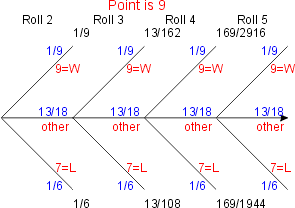I'm trying to simulate n games of craps. The code seems to make sense to me but I never get the right result. For example, if I put in n = 5 i.e. Fives games the wins and losses sum to something greater than 5. Here's how it's supposed to work: if initial roll is 2, 3, or 12, the player loses. If the roll is 7 or 11, the player wins.
People Also Ask

- We could keep improving the code even more, but lets leave it here until another day. This example is great to start coding in python. Hope you liked it and see you soon! TAKE A LOOK AT THE MORE COMPLETE VERSION OF THIS POST OVER HERE: Handle your 1st Python project and make a Dice Simulator Web App. If you have any trouble, leave me a comment.
- Python when combined with Tkinter provides a fast and easy way to create GUI applications. Tkinter provides a powerful object-oriented interface to the Tk GUI toolkit. It’s very easy to get started with Tkinter, here are some sample codes to get your hands on Tkinter in python.
- 2-player rolling the dice game in Python: Here, we are going to learn how to implement a python program for rolling the dice (2-player dice game) using abstract data class? Submitted by Anuj Singh, on July 31, 2019 Here, we will be going to design a very simple and easy game and implement it using abstract data class. The code consists of two.
- Craps Rolls Generator. To learn programming, try Udemy, Code Academy, or Learn Python. How the numbers are generated. I wrote a program in Javascript, using the.

In this chapter we will develop two programs involving loops that are slightly more involved than the simple examples from the last chapter.
1.1. Example: the game of craps¶
For the first example, we’ll write a program that allows a user to play the game of “craps”. It is played by rolling a pair of dice. Normally, the player (and spectators) bet on the outcome. We assume that a player starts with a fixed amount of money, called the “bankroll.”
Craps is played like this. Each round of the game has two “phases”:

In the first phase, you roll the dice once. If the result is 7 or 11, you win immediately and the round ends. If the result is 2, 3, or 12, you lose immediately, and the round ends. In all other cases the number you roll (which has to be a 4, 5, 6, 8, 9, or 10) is called the “point”, and you go on to the second phase.
In the second phase you keep rolling the dice until you roll a 7 or you roll the value of the “point” from the previous phase. If you roll a 7 first, you lose, and if you roll the point first, you win.
The payoff for the bets is always one-to-one: if you bet $10 and win, the bank gives you $10.
We can simulate rolling the dice using the randint function. To make it interactive, we’ll use an input statement to pause until the player presses the “Enter” key. Then we just generate two random values 1 through 6 and add them together.
We’ll start by writing a function to play a single round. We can assume that the amount of the bet is a parameter to the function, and the return value of the function is the amount won, where a negative number means a loss. The logic for the first phase just needs a conditional statement.
For the second phase, the player has to keep rolling the dice until she rolls a 7 or rolls the point. There is no way to predict how long that might take, right? So we’ll need a while-loop.
Step 1: What is the repeated action?
Step 2: How do we start out?
Step 3: How do we know whether to keep doing it?
When the loop finishes, we know that the value of ?roll? is either equal to 7 or equal to the point. We just have to check which one, in order to determine whether the player won or lost.
Here is the complete function:
To make this into a complete application, we need a user interface. The interface should allow the user to play again or quit, it should allow her to choose how much to bet, and should keep track of how much she’s won. This could be similar to the user interface for the number-guessing game in the last chapter. This part is left as an exercise.
1.2. Example: a loan table¶
In this section, the problem we are solving is based on the following scenario. Suppose you buy a car and you are making monthly payments. Two years later, you discover you need to trade it in for a minivan. How much do you still owe on your car?
Craps Python Code
The answer to a question like this is found by creating something called an “amortization table” for the loan. This is just a table that shows for each payment, how much went to pay interest, how much went towards paying off what you owe, called the principal, and how much you still owe, called the balance.
As always, we’ll start with a small concrete example. Suppose you borrow $100 at an interest rate of 10% per month, and you make monthly payments of $30. A month goes by, and you make your first payment. After that, how much do you owe?
The interest you owed for the month is 10% of 100 dollars, or 10 dollars.
The amount paid on your loan is 30 - 10 , or 20 dollars.
The balance you owe is now 100 - 20, or 80 dollars.
We can summarize all this by writing one line in a table:
Then, you make your second payment.
Next month you make another payment.
The process is similar for the next payment.
But now something different happens.
The interest you owe is 10% of 7.18, or 72 cents.The total amount you still owe is the 7.18 balance + 72 cents interest, which is a total of 7.90.Another 30 dollar payment would be too much! So you make a final payment of 7.90, and then the balance is zero
We’ll put the code into a function. The function needs three pieces of information: the amount of the loan, the payment amount, and the interest rate, so our function will have three parameters.
defprint_loan_table(amount,payment,annual_rate):
Craps Game Python Code
Let?s analyze what we have done and try to write the code.
Blackjack Python Code
Step 1: what is the repeated action?
Look at the calculations we did over and over again:
Introducing some appropriate variable names, we can write these steps by following what we did for the examples. For instance, in the first step, we had a balance of 100 dollars. We found the interest by multiplying the balance by the monthly rate of 10 percent. We found the amount paid on the principal by subracting the interest from the payment amount. We found the new balance by subtracting the principal from the balance.
To print a line of the table, we?ll use a format string with 12 spaces per column. Using a format specifier of ?percent 12 point 2 f? will round everything to two decimal places.
print('%12.2f%12.2f%12.2f'%(interest,principal,balance))That takes care of the loop body.
Step 2: how do we start out?
Initially the balance is the original amount borrowed. The monthly rate is the annual rate, divided by 12. At this point we have this much written. The statements representing the “repeated action” become the loop body.
Step 3: How do we know whether to keep doing it?
Looking back at our example, we knew it was the end when the amount we owed was only 7.90, which was less than the payment. So the loop should look something like this:
How did we know the amount owed? It was the balance, plus the interest for the month, that is:
balance+balance*monthly_rate
So we could write the condition as
while(balance+balance*monthly_rate)<=payment:
That takes care of the loop, but we’re not quite done. We still have to write the very last line of the table showing the final payment.
The complete function is shown below.

